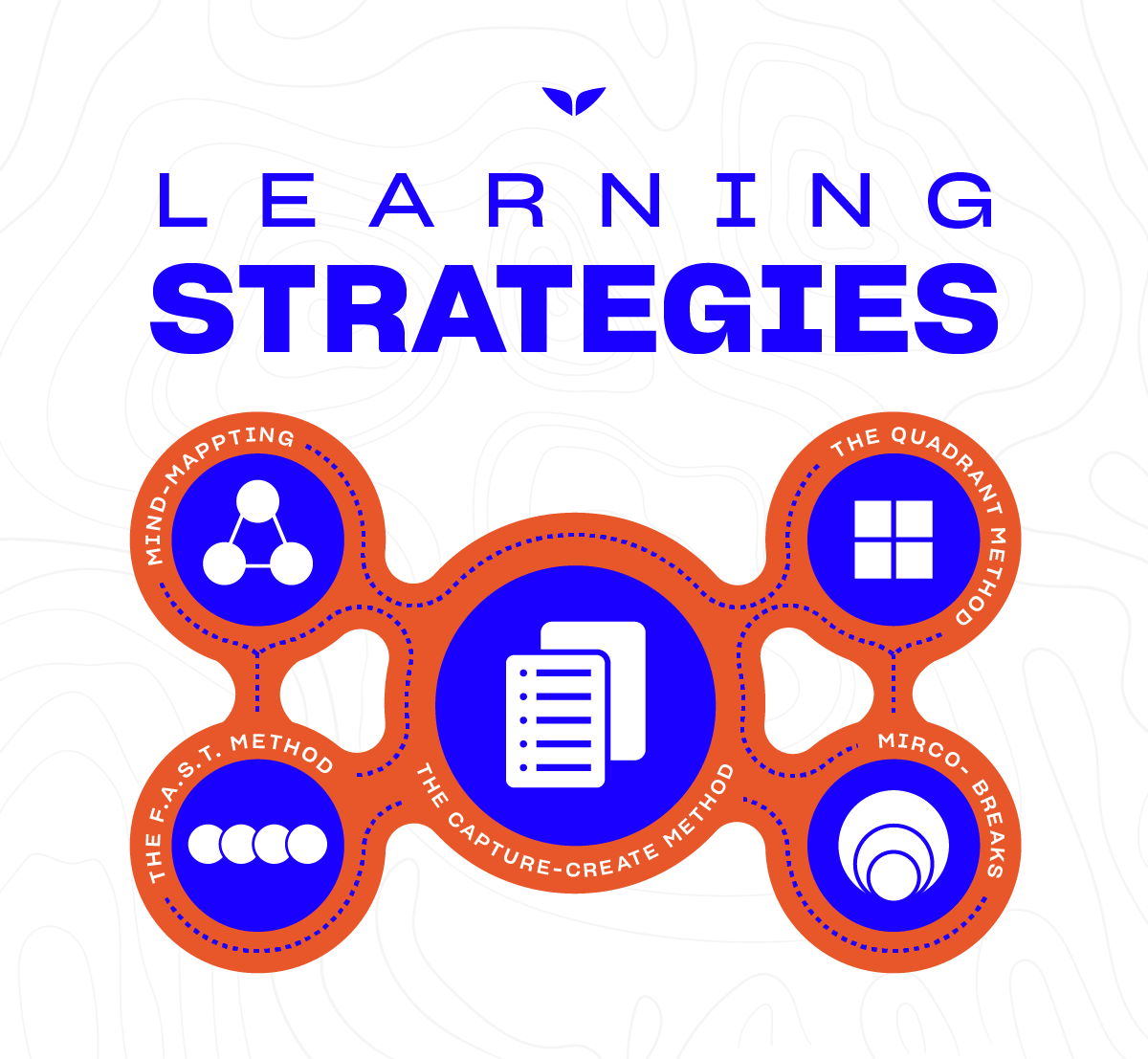In today’s fast-paced world, so many adult learners face challenges like managing time constraints, navigating information overload, and struggling with motivation.
So it comes as no surprise that when you sign up for a course to upskill, you feel like you fall short. And frustration ensues.
But having the right learning strategies can change that. And the proven methods perfected by brain performance coach Jim Kwik can help you retain what you learn and stay focused—while freeing up more of your time.
As Jim points out in his Super Reading Quest on Mindvalley, “Knowledge is not power—it’s potential power. It only becomes power when you use it.”
What are learning strategies?
Learning strategies are methods that optimize your learning experience. They’re designed to help you organize as well as practice the information you’ve learned in the most effective ways possible.
Knowledge is not power. It only becomes power when you use it.
— Jim Kwik, trainer of Mindvalley’s Super Reading Quest
In this day and age, where Internet users worldwide spend an average of over seven hours online every day, the need for effective learning strategies has never been greater.
As Vishen, the founder and CEO of Mindvalley, who’s made education hacking his life’s work, would say, “Facts and figures today no longer have to be stored in our mind. In fact, one might say that we’re becoming more forgetful as a species because we have knowledge at our fingertips.”
So, having all the artificial intelligence tools at your disposal these days isn’t always a good thing—if you don’t already know how to learn faster.
Active learning strategies
First introduced by educational theorists Charles C. Bonwell and James A. Eison in 1991, active learning is all about diving into the process and turning passive knowledge into real-world skills.
Unlike rote memorization, where you’re just cramming facts and hoping they stick, active learning is interactive and hands-on. It pushes you to analyze, question, and apply what you’re learning, making it much more likely to stay with you.
It sparks creativity and critical thinking, which truly sets you apart. And it gets results.
A meta-analysis of 225 studies in university STEM courses found that active learning reduced failure rates from 32% to 21%. It also helped students retain more information and ace their tests compared to traditional lectures.
Jim is living proof of how life-changing active learning can be. Growing up as “the boy with the broken brain,” he struggled until he realized that the traditional school system focused on what to learn, not how to learn.
Once he embraced new, more dynamic ways of learning, he says it felt like he “just activated [his] super brain.” Fast forward to today, and Jim’s teaching everyone—from students to Fortune 500 leaders—how to read faster, think clearer, and tap into their true potential.
And here’s the thing: you, too, can transform your learning experience. When you start learning in ways that actually work for you, the results can be game-changing.
5 learning strategies examples
“There’s no such thing as a good or bad learner—only a trained or untrained one,” Jim points out. This is a reminder that effective learning begins with understanding what works for you.
Now, let’s take a look at examples of learning strategies that embody this ethos:

1. The Capture-Create method
“The best notes aren’t verbatim transcriptions—they’re based on key ideas that help you retain and understand information better,” Jim says. That’s the Capture-Create method in a nutshell.
It ensures you’re not only retaining valuable information in your mind but also drawing it out at will to connect it to real-world situations when you need to.
For instance, let’s say you’re reading a self-help book and want to turn the ideas you’ve absorbed into actionable habits. Here’s how the capture-create method can help you:
- Split your page into two columns. Capture facts on one side and create reflections on the other.
- On the left, jot down essential takeaways such as “do daily gratitude” and “morning meditation.”
- On the right, brainstorm how to apply ideas. It can be “start a gratitude journal” and “track meditation sessions on an app” to complement the notes on the left.
- Add any personal insights or questions to deepen your understanding of why the information you’re capturing really matters to you.
2. Mind-mapping
Popularized by celebrated educational consultant Tony Buzan, this technique is a vital component of Jim’s super reading teachings due to its simple effectiveness.
“Your mind thinks in pictures, so mind mapping helps you see how everything relates,” says Jim. So you can say that this strategy makes use of what you inherently have—your imagination—to amplify how you organize and make use of ideas visually.
With everything mapped out to a tee, it’s much easier to spot connections between information, prioritize tasks, and stay focused on your higher-level goals. Sounds straightforward, but in the age of information overload and more productivity apps than you’ll ever know, this method’s simplicity can stretch a long way.
Here’s how to do it in any task-oriented setting:
- Start with your project’s name at the center of a page.
- Branch out into crucial areas like tasks, timelines, and goals.
- Use varying symbols, colors, or pictures to connect related ideas.
- Add sub-branches to any areas for deeper details, such as deadlines or team responsibilities.
3. Micro-breaks
Let’s face it: the human brain isn’t built to sustain intense focus for hours at a time. On the contrary, shorter, concentrated intervals can help it work and retain memory better.
This is why Jim’s always quick to advocate methods like the Pomodoro technique (where you work in focused 25-minute intervals followed by 5-minute breaks to recharge). Vishen, too, is a proponent of learning hacks; he once said that “productivity is not about working harder; it’s about working smarter,” and intentional breaks are a must to sustain focus and creativity.
Here’s how a micro-break works:
- You focus on a task for 25 minutes without distractions.
- You then take a 5-minute break to recharge.
This approach taps into your brain’s natural rhythms, preventing burnout and keeping your energy levels high. As studies in cognitive psychology have shown, short, intentional pauses can improve focus while reducing the risk of information overload.
Whether you’re working on a project or studying for an exam, micro-breaks can help you stay productive and engaged without feeling drained.
4. The F.A.S.T. method
Here’s a revolutionary framework by Jim to help you learn more effectively and efficiently. Each letter in this speed learning strategy represents a critical step to take, and together, they form principles that transform passive learning into an engaging, results-driven experience.
This method works best when you need to absorb complex information in short amounts of time, like gearing up before a big presentation or a big exam.
Let’s unpack each step and how to apply them:
F for “forget”
Clear your mind of distractions and preconceived notions to make more mental space for new knowledge.
How to do it:
- Write down any lingering thoughts or to-do tasks in your head.
- Let go of any that indicate, “I already know this.”
- Learn new information with an open mind.
A is for “active”
Engage actively with a learning material by processing and interacting with it instead of passively consuming it.
How to do it:
- Write your notes by hand.
- Ask questions—even the hard ones.
- Reflect on how to apply what you’ve learned to real life.
S is for “state”
The way you feel at any given time impacts memory and focus. So, ensure that you’re in a positive, energized state whenever you’re learning something new.
How to do it:
- Change your posture from time to time to shift your energy during learning.
- Smile—this always helps inject positivity into your learning experience.
- Move around the space you’re in to keep focused.
T is for “teach”
Teach what you’ve learned to something else. Doing this improves your own retention of the information.
How to do it:
- Share your knowledge with a friend or colleague.
- Explain concepts out loud. ”Hearing” yourself communicating the information will prime you to understand it better and recall it more.
5. The quadrant method
A Jim favorite, this method simplifies the learning process by breaking information into sections. The rationale behind this approach boils down to structure.
“When you organize information, it becomes more easily retainable,” Jim explains. By splitting what you’re learning into manageable categories, you can focus on what matters most much more quickly.
This method is best used when you’re reviewing technical information, such as reading a case study for work or trying to make sense of your health report.
So forget drowning in your sea of scattered notes; here’s what you can do instead:
- Divide a page into four quadrants.
- Label each section with “who,” “what,” “when,” and “where.”
- Jot down the details you’ve read and observed under each category to properly group related ideas.
The quadrant method’s clear structure keeps your thoughts organized and ensures nothing important gets missed.
5 best learning strategies for students
Laptops buzzing with open tabs, digital notes scattered across apps, and AI tools offering suggestions you’re not sure you need—it’s the modern student struggle. In that place where you’re torn between wanting to absorb more knowledge and dealing with your overwhelm, the right learning strategies can be your saving grace.
Thankfully, no matter where you’re with learning, these study strategies inspired by Jim’s work can help you break free from the chaos and recharge your learning experience.
1. Tame that loud reader in your head
One of the most common barriers to reading faster is subvocalization, the habit of silently “saying” each word in your head as you read. While this feels natural, it significantly slows down your reading speed, limiting how much information you can process in a given time.
According to Jim, fast readers don’t rely on their inner voice. Instead, they process words visually, allowing them to read faster and retain more information.
Here’s the lowdown on how you can break the habit:
- Visualize the content. Picture the meaning of words as images instead of “hearing” them.
- Engage your mind elsewhere while reading. Try counting, tapping your fingers, or chewing gum to distract your focus from your inner voice.
- Chunk words together. Focus on reading groups of words or phrases instead of individual ones to reduce dependency on subvocalization.
By turning to this strategy, you can process content more efficiently and master how to read better and faster without losing comprehension.
2. Use a visual pacer to improve focus
Remember when you were told in school not to use your finger while reading? Turns out, that advice was wrong. Using a visual pacer—like your finger, a pen, or a stylus—can guide your eyes smoothly across the page, reducing backtracking and keeping your focus on track.
Research on the impact of eye movement control on learning shows that this technique can activate your brain’s tracking system, triggering faster and more consistent reading. It’s no wonder why Jim often credits it for accelerated learning.
To hone in on this skill, start with shorter text before moving on to longer passages. By doing this daily, you get to boost your studying prowess like you’ve never before.
3. Practice spaced repetition
Cramming vast chunks of information into your head in one go isn’t sustainable. It might get you to pass a test tomorrow. But notice how easy it is to forget that information a month later when you need it again.
The much better alternative? Spaced repetition—Jim’s preferred technique for retaining knowledge long-term.
The best ways to apply this technique include:
- Expanding your vocabulary with ease,
- Memorizing essential formulas for quick recall, and
- Retaining significant historical dates effectively.
This method involves reviewing learning material at increasing intervals over time. Neuroscientifically speaking, it works because the brain’s neural connections get strengthened, and as a result, you tend to forget less in the face of frequently reviewed information.
4. Embrace microlearning
Juggling multiple subjects while trying to stay sane? That’s where microlearning comes in to support you—it’s a learning hack that keeps your brain from going into overdrive.
By breaking information into small, digestible chunks, you get to stay focused without feeling like you’re drowning in textbooks. Remarkably, the art of bite-sized learning is approved by science: your brain is wired to remember more when information comes in short bursts instead of endless study marathons.
If you’re wondering how to start, microlearning apps like Mindvalley make this process seamless. They fit right into your busy schedule, with quick lessons and interactive features that keep you motivated. Whether you’re prepping for finals or learning a new skill, 10-15 minutes a day is all you need to stay sharp and make steady progress.
5. Don’t say no to cohort-based learning
Unlike self-paced methods, this approach allows you to progress alongside others, sharing insights, tackling questions together, and staying motivated through peer support.
When you learn with others, you not only retain information better, but you also gain new perspectives and ideas that you might have missed studying alone.
Jimmy Naraine, trainer of Mindvalley’s Course Pro Quest
Jimmy Naraine, an award-winning educator and the trainer of Mindvalley’s Course Pro Quest, explains that learning with others, cohort style, can significantly enhance information retention.
“When you learn with others, you not only retain information better, but you also gain new perspectives and ideas that you might have missed studying alone,” he says.
If you typically prefer self-paced learning, switching things up occasionally can be a game-changer. Collaborative environments allow you to discuss concepts, share insights, and hold yourself accountable—key benefits of cooperative learning strategies.

BONUS: How to choose the right strategy for you
Knowing society’s average IQ scores for every age and theories of intelligence may be helpful, but this shouldn’t corner you into chasing the “perfect” learning strategy—because the truth is, there’s no such thing.
Intelligence isn’t a fixed, defined box to check off the list, but rather, a nuanced spectrum of abilities that can change as you grow. So, in the end, what matters most is that you’re learning in ways that are right for you—with your unique needs, goals, and circumstances factored in.
To discover the right strategy for you, start by exploring these important factors:
1. Your learning style
Are you a visual learner who thrives on pictures and diagrams? Or do discussions and hands-on practices help ideas stick?
Mind mapping, for example, works wonders for visual learners, as it can reveal connections between ideas. Reflective thinkers, on the other hand, may do better with Jim’s capture-create method, as it’s more about translating deeply processed information into actionable insights.
Recognizing how you learn best is the first step toward selecting a strategy that aligns with your natural strengths.
2. Your goals
Are you trying to pass an exam, master a skill, or gain a deeper understanding of a topic? Defining your objectives can help you land the right strategy for you.
Knowing your “why” is also what separates great learners from average ones. Vishen, in his Mastering the Growth Mindset Quest on Mindvalley, explains it best: “Transformation is different from knowledge. It’s wisdom—a deeper understanding of your role, your work, and how you show up in the world.”
So, if you’ve ever felt the urge to learn something but weren’t sure why, take a moment to reflect on your reasons to learn. And who knows? You might discover unexpected motivations that, when understood further, can accelerate your self-transformation journey.
3. Your schedule
To keep your learning experience effective, be realistic about how much time you can dedicate to it. Your schedule often dictates which strategies will fit best into your routine.
If your days are packed, then you may benefit more from quick, focused lessons. Imagine mastering a single concept or skill in less than 20 minutes a day—without feeling overwhelmed.
Of course, whenever you have more time, schedule cohort-based learning sessions to review and share insights on what you’ve learned alone.
By working smarter, not harder, you can channel your inner Jim Kwik, even with a busy life.
4. The subject matter
Not all topics are created equal, so neither are the strategies for learning them. The subject you’re studying often dictates the best way to approach and retain information.
For structured subjects like engineering or finance, the quadrant method is a lifesaver. It breaks down complex information into manageable sections, making it easier to process and recall.
In contrast, creative or discussion-heavy topics thrive in cohort-based settings, where live interactions and peer insights deepen your engagement and understanding.
That said, learning isn’t static. Stay flexible and open to adjusting your methods as the material evolves.
By aligning your strategy with the subject, you’ll not only learn efficiently but also retain the information that matters most.
5. Your source of motivation
How you find the will to learn says a lot about the learning strategy you’d opt for in any given time and situation.
If staying consistent is generally your Achilles’ heel, cohort learning or study groups can keep you on track. Throw in some gamified methods like spaced repetition on top of it, and the learning process can become even more enjoyable.
But if you’re in a season where upskilling your unique career is the priority, then learning alone, at your own pace, would suit you more.
Ultimately, the right strategy is the one that fits seamlessly into your life, not takes away from it. And it should empower you to learn smarter, not harder.
Awaken your unstoppable
The world’s bursting at the seams with information. So the challenge isn’t finding what to learn; it’s knowing how to learn well.
Jim Kwik can help you do just that. This free Become a Super Learner Masterclass is 87 minutes worth of transformative tips from the brain coach himself, including:
- 10 hacks to unlock your brain’s potential
- The one tried-and-test skill to beat “information overload”
- Delicious foods that help you clear mental fog
- The best morning routine for brain priming
- A five-minute exercise to boost cognition
These cheat codes have helped many people around the world learn and perform better in life, no matter their learning backgrounds and walks of life.
Take the story of Vsevolod Rychkov, a software engineer from Russia. He loved reading and recognized the importance of accelerating this skill at his workplace.
After discovering Jim’s speed reading techniques on Mindvalley, “I could deeply internalize technical information and juggle multiple things at once.” And what’s even more amazing? His love for reading deepened like never before. “Now, I read much faster (3x and improving) and will be able to surpass my reading goals for this year with ease.”
Stories like Vsevolod’s are proof that having the right learning strategy at hand can accelerate your growth. So, take a chance on yourself—and awaken your unstoppable at Mindvalley.
Welcome in.










